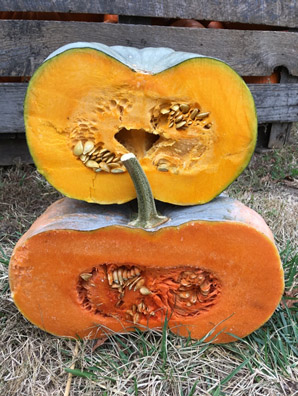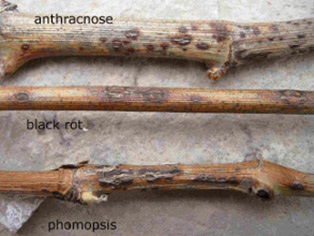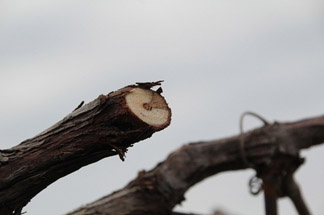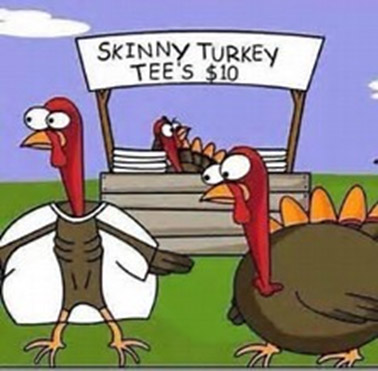Address any questions or comments regarding this newsletter to the individual authors listed after each article or to its editors, Nathan Johanning, 618-939-3434, njohann@illinois.edu or Bronwyn Aly 618-695-6060, baly@illinois.edu. The Illinois Fruit and Vegetable News is available on the web at: http://ipm.illinois.edu/ifvn/. To receive or be removed from email notification of new postings of this newsletter, contact Nathan Johanning or Bronwyn Aly at the phone numbers or email addresses above.
In This Issue:
Upcoming Programs (listings for beginning and established growers)
Regional Reports (north central Illinois, St. Louis Metro-east, southern Illinois)
Fruit and Vegetable Production and Pest Management (Use Dormant Pruning to Monitor and Manage Grape Pathogens, New Research on Spotted Wing Drosophila and Dropped Fruit, Managing Soil Fertility: Taking a "Good" Soil Sample)
Upcoming Programs
Check the Illinois SARE calendar for a full list of programs and links for registration.
http://illinoissare.org/ and http://illinoissare.org/calendar.php
Also see the University of Illinois Extension Local Food Systems and Small Farms Team's website at:
http://web.extension.illinois.edu/smallfarm/ and the calendar of events at http://web.extension.illinois.edu/units/calendar.cfm?UnitID=629.
- Great Lakes Fruit, Vegetable and Farm Market EXPO, December 5-7, 2017 in Grand Rapids, MI. The EXPO includes educational programming for fruit, vegetable and greenhouse growers, and for farm marketers. Pre-register by November 15 to save money at: http://www.glexpo.com/
- Managing Weeds in the Garden, Non-Chemically Webinar, Thursday, December 14, 2017 at 11:30 a.m. to 12:30 p.m. CST. This webinar will discuss weed types in general and address various options of organically managing weeds in different situations. The webinar is free to participate but pre-registration is required. Find registration information at: https://web.extension.illinois.edu/registration/?RegistrationID=17481. Registration will close on December 12, 2017. For questions, or more information, contact James Theuri at 815-933-8337 or jtheu50@illinois.edu.
- Growing Staple Crops for Local Markets, Tuesday, December 19, 2017 - 9:00 a.m. to NOON, Will County Extension Office, 100 Manhattan Dr., Joliet IL 60443. The program will discuss small grains and staples that can grow in backyards or on a larger scale, addressing agronomy, challenges, marketing, and resources available for information. On-going work with beans, oilseeds, hazelnuts, Chinese chestnuts, open-pollinated corn and upland rice will be presented. Cost for participation is $10 per person. Register online at https://web.extension.illinois.edu/registration/?RegistrationID=17494 by December 15 to reserve your spot. If you need more information, call 815-933-8337 or email James Theuri at jtheu50@illinois.edu.
- 2018 Illiana Vegetable Growers Symposium, Thursday, January 4, 2018 8:00 a.m. – 4:00 p.m. CST at Teibel's Restaurant, Schererville, IN. The program is packed full of useful information for vegetable farmers, including market gardeners. Topics include management of tomato bacterial canker, sprayers for controlling insects in sweet corn, new dicamba regulations, and updates on the federal food safety regulations. Afternoon sessions will offer tracks in marketing or production issues including cover crops and high tunnels. See the complete program and registration form at http://tinyurl.com/ivgs2018. For more information, contact Nikky Witkowski at Purdue Extension-Lake County: 219-755-3240 or nikky@purdue.edu.
- 2018 Illinois Specialty Crops, Agritourism, & Organics Conference, Wednesday-Friday, January 10-12, 2018. Crowne Plaza Hotel, Springfield, IL. Save the date; more details closer to event. For more information visit the ISGA website.
- 2018 Gateway Small Fruit & Vegetable Conference, Wednesday, February 7, 2018. Regency Conference Center, O'Fallon, IL. Save the date; more details closer to the event. For more information contact Elizabeth Wahle at wahle@illinois.edu or 618-344-4230.
- 2018 Southern & Southwestern Illinois Commercial Tree Fruit Schools, Tuesday & Wednesday, February 13 & 14, 2018, Mt. Vernon & Hardin, IL. Save the date; more details closer to event. For more information contact Laurie George at (618) 242-0780 or lgeorge@illinois.edu
- 2018 Illinois Summer Horticulture Field Day, Thursday, June 7, 2018. Annual Illinois State Horticulture Society annual summer field day will by hosted by Flamm's Orchard in Alto Pass, IL. Save the date; more details closer to event.
Regional Reports
From the St. Louis Metro-East... Since the last newsletter, the St Louis Metro-east received much needed rain but not enough to pull the region out of drought conditions. Much of the region is still abnormally dry to moderately droughty. The region has also had periods of below average temperatures, with overnight temperatures roller-coasting between the upper 50's and lowers 20's. Late crops of field tomatoes and beans were finished off with the first drop below freezing temperatures, but cold tolerant crops like peas, beets, and leaf lettuce are still surviving.
Elizabeth Wahle (618-344-4230; wahle@illinois.edu)
From north central Illinois... What a season it has been! And if you have any type of season extension, you may still be full into fall harvest. For others prepping beds for winter, you are likely crunching the numbers from this year, finding strengths and weaknesses in your growing and sales operation. We are doing something similar for our donation garden here in McDonough County. Ours is more for reporting back for grant requirements, clerical reports for administration, and preparing to apply for more grants. We had a great first year for our new GIFT (Growing Illinois Food Together) Garden. Approximately, 275 square feet of growing space yielded 741 pounds of produce. Our high tunnel and low tunnel continue our harvest, likely into December. Next year we will more than double our growing area and invest in perennial crops like asparagus.
We kept records on the different crops we grew and their harvested weight. Record keeping items should include inputs like fertilizers, soil amendments, irrigation supplies, even utility bills if they apply to your farm. Additionally, as commercial growers, you record sales of crops. All of these items pulled together, help to identify trends, declining markets and potential markets. Keeping records and good notes help to make business decisions for next year, especially now as the seed catalogs begin to stack up on the desk and the short days drive us inside.
Our new low tunnel is doing a great job of protecting carrots, turnips, kale, and head lettuce growing in the field. The high tunnel has those crops, plus bok choi, Swiss Chard, and parsnips. Having never grown parsnips, I was delighted with the crop this year. Similar to carrots, parsnips can be left in the ground over winter and harvested when needed. I made a short video on my first parsnip harvest. Check it out HERE.
Chris Enroth (309-837-3939; cenroth@illinois.edu)
From southern Illinois... Well for most of us the growing season came to an official end around the 28th to 29th of October as we had temperatures dip down below freezing halting all of our summer annuals in their tracks. Since then, we have for the most part stayed around average with most days in the 50s for highs and 40s and 30s for lows. We have had a few scattered warmer days and also a few other mornings in the mid to upper 20s; 28˚ is the coldest I have seen at my house in Murphysboro. We have also started to replenish our extremely dry soils and have gotten between 1" - 2" of rain in these first few weeks of November. Yesterday (10/14) it was just dry enough to do some field work (drilling late cover crops etc.), but we had light rain set in early this morning which now has things a little too wet again for a few days with about 0.3" here in Murphysboro. Overall, these rains are just a teaser for what we really need to get to replenish the water back in the soil before the next growing season.

Cross-section of blue jarradale (top)
and fairytale (bottom) specialty
pumpkins. Photo: N. Johanning
Out in the field, things have obviously slowed down for many, but cole crops and greens are still thriving and quite happy with the cool modest November temperatures out in the field and under high tunnel protection. Even though the ornamental market for pumpkins has dwindled, many chefs and avid home cooks have looked to many of our "specialty pumpkins" for their more original purpose, as food. In case you haven't ever taken the time to look, here is the cross section of a 'blue jarradale' and 'fairytale.' Many people are amazed at the color, amount, and quality of flesh inside some varieties. Often I hear of blue jarradales being used for soups or baked as a side dish, while fairtales (or any of the tan skinned varieties) being used for pies, as they are in the same family as the "processing" pumpkins used to make canned pumpkin.
Although getting to the end of the cover crop planting season, many could still get away with planting cereal rye now, especially if we stay with this current pattern and the temperatures don't turn off too cold. Now is a good time to pull up that old black plastic and get fields "prepped" and ready for next year. Also, with the colder weather don't forget to check antifreeze in equipment and winterize or drain any sprayers or tanks. You don't want to bust hoses, joints, or fittings. My problem spot in the past is an inline strainer on a boom sprayer that I just take completely out otherwise it always seems to find just enough water to cause some kind of leak the next year. Also, it is a good time to come up with those needed equipment repairs that we may have pieced together at the time to make them work and make some "permanent" fixes. While this often turns more into a wish list than a reality, we all know that those few times you actually do make those fixes it is so nice to hop on or hook up that piece of equipment next spring knowing that it is fixed...at least until the next thing breaks :).
Nathan Johanning (618-939-3434; njohann@illinois.edu)
Fruit and Vegetable Production and Pest Management
Use Dormant Pruning to Monitor and Manage Grape Pathogens

Photo: University of Kentucky Extension
Most common grape pathogens occurring in the Midwest overwinter on the grapevine itself or in fallen grape leaf litter. Pathogens like anthracnose, black rot and Phomopsis cause visible lesions on spurs, canes and cordons that growers can use for identification purposes and assessing disease level. The first step in control is removing as much diseased and dead wood as practical during dormant pruning. Follow-up with destroying diseased prunings before budbreak by shredding, disking or plowing into the soil, or burning. Otherwise, infected prunings left in the vineyard can serve as inoculum when conditions are optimal.

Eutypa lesion in cross section.
Photo: E. Wahle
During dormant pruning, be on the lookout for the fungal wood disease Eutypa. In cross section, the cane, cordon or trunk will have a dead pie-shaped section. In these cases, remove entire vines or prune out trunks, cordons, or spurs of symptomatic vines. Gather all infected wood and remove it from the vineyard or burn it. Spores of Eutypa spread very short distances (up to 6 feet max), so removal of infected wood is effective in reducing new infections. Research has shown that vines pruned early in the winter, when they are dormant, do not heal as quickly and the pruning wounds are susceptible to Eutypa infection for 4 to 5 weeks. In contrast, pruning wounds made late in the dormant season heal within days, and thus resist infection soon after pruning. Although susceptibility to Eutypa is unknown for many of the cultivars grown in the Midwest, Concord and Maréchal Foch are two cultivar know to be highly susceptible. Check the Midwest Fruit Pest Management guide for a complete list of cultivar susceptibility https://ag.purdue.edu/hla/Hort/Documents/ID-465.pdf . One way to reduce new infections of Eutypa in problematic blocks is through double pruning. Double pruning should be thought of as a type of delayed pruning. Make the 1st pruning pass in December, leaving all canes ~8" or more in length. Make the 2nd and final pass in February or March. Because the pathogen grows slowly, it is unlikely to grow from the pruning wounds at the tips of the 8-inch canes down to the cordon in between the two pruning passes.
Elizabeth Wahle (618-344-4230; wahle@illinois.edu)
New Research Studies Spotted Wing Drosophila on Dropped Fruit
A study from Michigan State University, recently published in the Journal of Economic Entomology, evaluated the impact of removing fallen fruit on the number of Spotted Wing Drosophila breeding flies and surveyed various dropped fruit crops for SWD presence. The following link provides an overview of their study. https://entomologytoday.org/2017/10/26/fallen-fruit-breeds-invasive-flies/
Managing Soil Fertility: Taking a "Good" Soil Sample
Now is often the time of year that we think about soil sampling and getting a handle on the fertility needs of our fields. This is a great time to get this out of the way while soil conditions are good to pull cores and the weather temperatures are still fairly decent. One of the keys to getting good soil sample results is to take a good sample. Almost any lab (or soil fertility instructor) will tell you that your results are only as good as the quality of the sample you take. Here are a few recommendations on how to take a "good" sample:
- Choose sample areas based off of previous management, crop history, slope, and soil type. Fields can vary in nutrient levels based off of management practices that occurred even many years before. Some examples of things to consider would be old field borders, band applied fertilizers (especially Lime, P, & K), or any differences you have observed in crop growth. If you do not sample these areas separately, the results from one area might dilute or inflate the level, not giving you an accurate assessment of the field.
- Size of each sample area. Generally I would recommend a maximum sampling area size of no more than 5 acres (2.5 acres preferred) at least until you have a baseline understanding of the field. However, for many specialty crop growers with smaller field sizes this would probably be much smaller with samples potentially every half acre or less. Again I would base the size more off of management and history than just a set number of acres.
- Pull 6 to 10 cores (6 to 7 inches deep) and mix together to form your sample. This gives you a good representation of the variability of an area, and this number of samples helps to control for any small-scale variability in the field. Mix well and fill to the fill line on the soil sample bag, which is usually no more than a pint. You can discard any extra soil; no need in paying for extra shipping and most soil labs already have an abundance of extra soil so they probably would prefer not have any more in excess.
- Use a probe or spade to get a sample that is representative of the top 6 -7 inches of the soil. The reason being we typically consider this zone in the soil to be the primary rooting zone and your sample should equally reflect that profile. You want to have just as much soil from 6 inches down as the top inch so you are not biasing the sample for possible increased fertility. A soil probe is the easiest tool to do this with.
- Keep good records. Record the sampling areas and how you designated them. This will help you when you take samples in the future (every 3-4 years) to be able to compare back so you can see how your management practices have changed the soil fertility levels. Also, if you are comparing from year to year, it is recommended to always try and sample at the same time of year for the most consistency.
Hopefully this gives you a few thoughts on how to take a "good" soil sample as it really is crucial to success. Also, if you are looking for a soil lab you can find a listing at https://extension.illinois.edu/soiltest/, or from the Illinois Soil Testing Association at http://www.soiltesting.org/5certifiedlabs.html.
Nathan Johanning (618-939-3434; njohann@illinois.edu)
Less Seriously...
I had to include this joke that my 1st grader came home with this week. Sometimes we just have to revisit the innocent silliness of bodily functions and brutal honesty.
Hey Mom, whats the difference between broccoli and boogers?.........Kids will eat boogers!!!

https://www.bing.com/images/search?q=thanksgiving+humor+jokes&qpvt=thanksgiving+humor+jokes&FORM=IGRE
University of Illinois Extension Specialists in Fruit and Vegetable Production & Pest Management
Extension Educators – Local Food Systems and Small Farms |
||
Bronwyn Aly, Gallatin, Hamilton, Hardin, Pope, Saline, and White counties |
618-382-2662 |
|
Katie Bell, Franklin, Jackson, Perry, Randolph, & Williamson counties |
618-687-1727 |
|
Sarah Farley, Lake & McHenry counties |
847-223-8627 |
|
Nick Frillman, Woodford, Livingston, & McLean counties |
309-663-8306 |
|
Laurie George, Bond, Clinton, Jefferson, Marion, & Washington counties |
618-548-1446 |
|
Zachary Grant, Cook County | 708-679-6889 | |
Doug Gucker, DeWitt, Macon, and Piatt counties |
217-877-6042 |
|
Erin Harper, Champaign, Ford, Iroquois, and Vermillion counties |
217-333-7672 |
|
Grace Margherio, Jackie Joyner-Kersee Center, St. Clair County |
217-244-3547 |
|
Grant McCarty, Jo Daviess, Stephenson, and Winnebago counties |
815-235-4125 |
|
Katie Parker, Adams, Brown, Hancock, Pike and Schuyler counties |
217-223-8380 |
|
Kathryn Pereira, Cook County |
773-233-2900 |
|
James Theuri, Grundy, Kankakee, and Will counties |
815-933-8337 |
|
Extension Educators – Horticulture |
||
Chris Enroth, Henderson, Knox, McDonough, and Warren counties |
309-837-3939 |
|
Richard Hentschel, DuPage, Kane, and Kendall counties |
630-584-6166 |
|
Andrew Holsinger, Christian, Jersey, Macoupin, & Montgomery counties |
217-532-3941 |
|
Extension Educators - Commercial Agriculture |
||
Elizabeth Wahle, Fruit & Vegetable Production |
618-344-4230 |
|
Nathan Johanning, Madison, Monroe & St. Clair counties |
618-939-3434 |
|
Campus-based Extension Specialists |
||
Kacie Athey, Entomology |
217-244-9916 |
|
Mohammad Babadoost, Plant Pathology |
217-333-1523 |
|